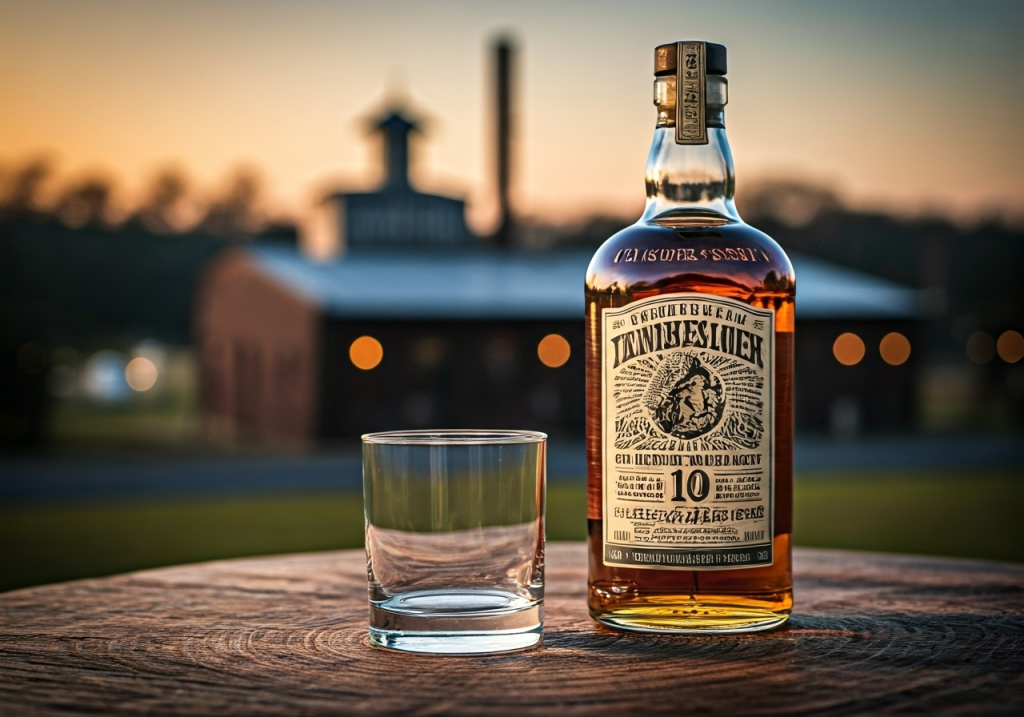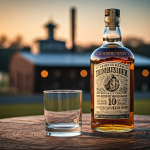Key Highlights
- The history of Jack Daniel whiskey is a globally recognized Tennessee whiskey, crafted at the historic Jack Daniel Distillery in Lynchburg, Tennessee, since the late 19th century.
- The origins of Jack Daniel’s involve the mentorship of Nathan ‘Nearest’ Green, the first master distiller, whose expertise shaped the whiskey’s signature style.
- Jasper Newton “Jack” Daniel’s upbringing in Moore County, family influences, and early apprenticeship with Dan Call played key roles in his journey.
- The distillery survived Prohibition, various controversies, and brand myths, continuing to innovate with collectible bottles and limited editions.
- Iconic for its unique production processes like charcoal mellowing and the Lincoln County Process, Jack Daniel’s legacy endures worldwide.
Introduction
Jack Daniel’s whiskey stands as one of the most iconic American spirits, renowned for its bold flavor and heritage as Tennessee whiskey. Produced at the Jack Daniel Distillery in Lynchburg, Tennessee, this brand has become synonymous with quality and tradition. Over the years, the Jack Daniel’s legacy has intertwined history, innovation, and unmistakable craftsmanship, making it a staple in whiskey culture. As you explore its past, you’ll discover how Jack Daniel’s evolved from a local distillery into a global powerhouse.
Jack Daniel’s Early Life and Family Background
Jasper Newton Daniel, famously known as Jack Daniel, emerged from humble beginnings in Lynchburg, Tennessee. His early life was shaped by a large family, the loss of his mother, and the challenges of the post-Civil War South. These experiences gave young Jack a strong sense of fairness and independence.
Raised in Moore County, Jack’s family background included Welsh, Scottish, and English roots. His father’s remarriage and subsequent passing led to Jack being taken in by family friends, further influencing his values and work ethic. This foundation set the stage for his remarkable future.
Childhood in Lynchburg, Tennessee
Life in Lynchburg, Tennessee, offered Jack Daniel a unique upbringing in the heart of Moore County. Born as the youngest of ten children to Lucinda and Calaway Daniel, young Jack experienced hardship early on, with his mother passing away when he was just a boy. The family lived in a rural community, deeply embedded in Southern culture, where values like independence and resilience were essential.
Jack struggled to get along with his stepmother after his father’s remarriage, which added to his sense of wanting to carve his own path. The Daniel family had a rich heritage, with ancestors who emigrated from Wales and Scotland. After his father’s death during the Civil War, Jack’s formative years were marked by further upheaval.
Eventually, Jack was adopted by family acquaintances, which led to his introduction to the distilling world. These early experiences in Lynchburg instilled in him a drive to succeed and a keen sense of justice—traits that would define his later life.
Family Influences and Upbringing
Jack Daniel’s upbringing was profoundly impacted by his family’s history and values. Following his mother’s death and his father’s subsequent remarriage, Jack found himself in a blended family, which shaped his adaptability and sense of self-reliance. The Daniel family placed a strong emphasis on hard work, community, and fairness—principles that would guide Jack throughout his journey.
After losing his father, Jack was first adopted by Felix Waggoner and then taken in by Dan Call, a local preacher and distiller. These family transitions gave Jack a sense of belonging but also encouraged him to develop his own identity. His family’s support, coupled with the guidance from Call and others, fueled Jack’s interest in business and craft.
The influence of kin, mentors, and his Moore County upbringing provided Jack with the stability and moral compass needed to become a respected entrepreneur in the whiskey industry.
Entry into Whiskey Distilling
Jack Daniel’s entry into the world of whiskey distilling began at a young age, thanks to the mentorship and opportunities provided by those around him. His fascination with the craft was sparked by practical apprenticeships, where he learned the essentials of whiskey production from experienced masters.
Starting as an apprentice in the Dan Call distillery, Jack quickly progressed due to his determination and curiosity. His time learning under renowned figures, including the first master distiller, laid the groundwork for the future Jack Daniel’s brand.
Apprenticeship and First Steps
Jack Daniel’s journey into whiskey began when he was taken in by Dan Call, a local farmer and lay preacher who also ran a small distillery. Dan Call recognized Jack’s curiosity and drive, allowing him to apprentice at the distillery. Here, Jack absorbed the fundamentals of distilling and business operations.
During his formative years at the Call distillery, Jack displayed a remarkable aptitude for learning. He worked alongside skilled individuals and quickly grasped the technical and entrepreneurial aspects of the trade. As a young apprentice, Jack was exposed to the intricacies of production, from fermentation to bottling.
Dan Call’s mentorship and willingness to foster Jack’s development were crucial. When Call decided to leave the business for religious reasons, Jack took over operations. This transition marked the beginning of Jack Daniel’s rise as a master distiller and set the stage for his legendary whiskey.
The Role of Nathan ‘Nearest’ Green
Nathan ‘Nearest’ Green played a foundational role in creating Jack Daniel’s whiskey as the distillery’s first master distiller. Green, an African-American man with exceptional skill in the craft, was renowned for his expertise in the Lincoln County Process—a unique method of filtering whiskey through sugar maple charcoal.
Green served as both mentor and teacher to young Jack Daniel. He taught Jack the art and science of distilling, including the charcoal mellowing process that remains essential to the brand’s signature taste. Their relationship was one of mutual respect, built on shared dedication to quality.
After emancipation, Green continued to work with Jack Daniel and was pivotal in shaping the distillery’s early operations. His contributions, once overlooked, are now recognized as crucial to the development of Jack Daniel’s whiskey. As Fawn Weaver, an advocate for Green’s legacy, puts it, “Nathan Green’s expertise set the foundation for one of America’s most iconic spirits.”
The Founding of Jack Daniel Distillery
The official founding of the Jack Daniel Distillery signaled the start of a remarkable legacy in American whiskey. After receiving an inheritance from his father’s estate, Jack Daniel legally established his own distilling business, marking a new era for Tennessee whiskey.
Armed with official registration documents and a clear vision, Jack selected the perfect location in Lynchburg, Moore County. This decision would benefit from the area’s iron-free spring water and laid the groundwork for the distillery’s future success.
Establishment of the Distillery
The establishment of the Jack Daniel Distillery was a turning point for both Jack Daniel and the whiskey industry. Drawing on inheritance money and experience gained from his apprenticeship, Jack founded the distillery with legal registration in 1875—though the product label claims 1866, official records support the later date.
Jack acquired the land in Lynchburg where a pristine spring flowed, providing iron-free water ideal for whiskey production. This natural advantage, combined with his commitment to quality and innovation, quickly set the distillery apart. The early years saw Jack Daniel’s whiskey grow in reputation, eventually becoming one of Moore County’s most productive distilleries.
His attention to detail and insistence on fairness were reflected in every aspect, from the square bottle design to the meticulous production process. These foundations ensured the distillery’s continued growth and enduring popularity.
Selection of Lynchburg as Distillery Location
Choosing Lynchburg, Tennessee, as the home for Jack Daniel’s distillery was a strategic move rooted in the area’s unique resources. The distillery is nestled in “Stillhouse Hollow,” a limestone-rich hollow in Moore County, where a spring produces iron-free water. This water is a critical element in creating Tennessee whiskey, as iron can ruin the taste of whiskey.
The setting also provided the distillery with natural protection and a storied backdrop, enhancing the whiskey’s mystique. Lynchburg’s rural landscape, agricultural traditions, and access to local grains complemented the distilling process, allowing for consistency and quality.
The town’s location soon became synonymous with American whiskey culture, drawing visitors and enthusiasts from across the country. Today, Lynchburg’s identity is forever intertwined with Jack Daniel’s whiskey, making it a pilgrimage site for fans who want to experience the roots of the iconic brand.
Key Milestones in Jack Daniel’s History
Throughout its history, Jack Daniel’s has faced and overcome many challenges, marking significant milestones that shaped its enduring legacy. From surviving the grip of Prohibition to rebuilding its operations, the distillery has shown resilience and adaptability.
The brand’s growth continued through periods of expansion and increased recognition. Each milestone solidified Jack Daniel’s status as the quintessential brand of Tennessee whiskey, preserving its unique character while reaching new generations of drinkers around the world.
Surviving Prohibition and Rebuilding
Prohibition was a defining moment for the Jack Daniel Distillery, testing its resilience and adaptability. When Tennessee enacted statewide prohibition in 1910, legal distillation of Jack Daniel’s whiskey was halted. Lem Motlow, Jack’s nephew and successor, challenged the law in court, but with no success. The distillery was forced to move its operations to St. Louis and Birmingham, but these efforts failed due to quality issues.
Even after the repeal of Prohibition at the federal level in 1933, Moore County and Tennessee maintained restrictive state laws that delayed the distillery’s reopening until 1938. Lem Motlow, who had become a Tennessee state senator, played a key role in lobbying for changes to state law.
The distillery’s perseverance paid off. Jack Daniel’s emerged from these setbacks with renewed vigor, eventually reclaiming its position in the market. The brand’s survival during tough times reinforced the enduring spirit of Jack Daniel’s whiskey.
Expansion and Recognition
The years following Prohibition saw Jack Daniel’s steadily expand and gain international fame. Under the stewardship of Lem Motlow and subsequent generations, the distillery modernized its facilities and increased production to meet growing demand. The introduction of the iconic square bottle in 1897 and the “Old No. 7” label helped define the brand’s visual identity.
Jack Daniel’s whiskey won a gold medal at the 1904 St. Louis World’s Fair, boosting its reputation and opening new markets. The distillery continued to innovate, releasing new product lines such as Gentleman Jack, Tennessee Honey, and Single Barrel Rye, each contributing to the brand’s recognition.
Global distribution and clever marketing cemented Jack Daniel’s status as the world’s best-selling American whiskey. Today, its legacy is marked by both tradition and growth—a testament to its consistent quality and pioneering spirit.
Recipe Evolution and Production Process
Jack Daniel’s whiskey owes much of its success to a carefully guarded recipe and production process. While the core methods have remained true to tradition, subtle changes have occurred over time, reflecting shifts in technology and market preferences.
Key innovations include the Lincoln County Process, charcoal mellowing, and refinements in the mash bill and aging practices. These elements ensure that every bottle maintains the signature flavor profile that defines Tennessee whiskey and keeps Jack Daniel’s relevant, regardless of changing trends.
Charcoal Mellowing and Tennessee Whiskey Process
One of the hallmarks of Jack Daniel’s production is the Lincoln County Process, a unique method required for Tennessee whiskey. This process involves filtering the whiskey through ten feet of sugar maple charcoal before aging. Known as “charcoal mellowing,” it removes impurities and imparts a smooth, distinctive character.
This extra step sets Tennessee whiskey apart from bourbon, and Jack Daniel’s has remained committed to this method for generations. The use of iron-free spring water from Lynchburg further enhances the whiskey’s flavor, ensuring consistency and quality.
The Lincoln County Process is not just a technical detail—it’s a symbol of authenticity and a critical part of Jack Daniel’s legacy. As the distillery expanded, this process was preserved and even enshrined in state law, guaranteeing that every bottle of Jack Daniel’s stays true to its Tennessee roots.
Changes in Mash Bill and Aging over Time
Jack Daniel’s mash bill—a mix of 80% corn, 12% rye, and 8% malted barley—has remained largely consistent. This blend, combined with the sour mash process, delivers the robust flavor you associate with the brand. The sour mash technique uses remnants from previous batches to help kick-start fermentation, enhancing both consistency and depth.
However, the aging process and proof have seen some changes. In the past, the flagship Black Label whiskey was bottled at 90 proof, but it was gradually reduced to 80 proof by 2002. This adjustment reflected changing market demands and regulations, though higher-proof limited editions and single barrel releases still honor the brand’s traditional strength.
Despite these changes, Jack Daniel’s has never compromised on quality. The brand’s commitment to using new oak barrels and precise aging ensures that every bottle maintains the classic taste whiskey enthusiasts expect.
Controversies and Lesser-Known Stories
Jack Daniel’s history is not without controversies and intriguing tales. The brand has faced disputes over its founding date, stories about Jack’s death, and questions about who truly shaped its whiskey.
Perhaps most notably, the story of Nathan ‘Nearest’ Green, the enslaved man who became the first master distiller, has only recently gained widespread recognition. Myths and legends, from the origins of “Old No. 7” to workplace stories, add depth and complexity to the brand’s colorful past.
The Story of Nearest Green’s Legacy
Nathan ‘Nearest’ Green’s contributions to Jack Daniel’s whiskey have come to light thanks to the efforts of researchers and advocates like Fawn Weaver. Green, once enslaved, was recognized by Jack Daniel as the distillery’s first master distiller. His expertise, especially in the Lincoln County Process, laid the groundwork for the whiskey’s unique profile.
For years, Green’s pivotal role was overlooked in official histories. Recent initiatives have sought to give him proper credit, leading to the establishment of the Nearest Green Distillery and the Nearest Green Foundation, which honors his memory and impact.
Weaver’s research and storytelling have sparked a renewed appreciation for Green’s legacy. As she noted, “Understanding the true story of Nearest Green allows us to celebrate the diverse roots of American whiskey.” Today, both Jack Daniel’s and whiskey lovers now recognize Nearest Green as a foundational figure in the brand’s story.
Brand Myths and Historic Disputes
Jack Daniel’s history is riddled with myths and debates. One of the most enduring legends involves Jack Daniel’s death. The story goes that he died from blood poisoning after kicking his safe in frustration, but modern biographers, such as Peter Krass in “Blood & Whiskey: The Life and Times of Jack Daniel,” contest this account, suggesting it’s more myth than fact.
Another disputed detail is the distillery’s founding date. While the label says “Est. & Reg. in 1866,” official documents point to 1875. The origin of the “Old No. 7” brand is also shrouded in speculation, with various explanations about government registration numbers or even a friend’s chain of stores.
These stories have become part of Jack Daniel’s lore, adding intrigue to its legacy. They illustrate how brand history can blur with legend, keeping the whiskey’s mystique alive for new generations.
Iconic Bottles and Collectibles
Jack Daniel’s has produced some of the world’s most collectible and historic whiskey bottles, each with its own story. The iconic black label “Old No. 7” and its square bottle have become symbols of integrity and fairness in American whiskey.
Special editions and limited releases, such as Sinatra Select and commemorative bottles, attract collectors and enthusiasts alike. These bottles showcase the brand’s ability to honor tradition while introducing new expressions—making Jack Daniel’s a favorite among whiskey collectors everywhere.
Old No. 7 and Its Origins
No discussion of Jack Daniel’s whiskey is complete without mentioning Old No. 7—the flagship product and the face of the brand. Introduced in the late 1800s, the black label Old No. 7 comes in the instantly recognizable square bottle. Jack Daniel chose this design to represent fairness and integrity, values he held dear.
The origin of the “Old No. 7” name remains a topic of debate. Some say it refers to the government registration number assigned to the distillery, while others believe it commemorates a friend’s chain of seven stores. Regardless of its true beginnings, Old No. 7 has become a legendary brand identifier.
Collectors seek out vintage Old No. 7 bottles, especially those produced at higher proofs or with unique packaging. The bottle’s design and the whiskey inside have made it a symbol of American craftsmanship and a cornerstone of whiskey culture.
Limited Editions and Historic Releases
Jack Daniel’s has a rich tradition of creating limited editions and historic releases that celebrate milestones, partnerships, and famous fans. These bottles often feature distinctive packaging, higher proofs, or special finishes, making them highly sought after by collectors.
For example, the Sinatra Select honors Frank Sinatra’s devotion to Jack Daniel’s, while the Single Barrel series showcases exceptional barrels handpicked for their unique character. Commemorative bottles for anniversaries and state events add another layer of history to the brand.
Here is a table featuring some notable limited editions and their unique stories:
| Edition Name | Key Features / Significance |
|---|---|
| Sinatra Select | Tribute to Frank Sinatra; 90 proof; special cask blend |
| Sinatra Century | Released for Sinatra’s 100th birthday; 100 proof |
| Tennessee Bicentennial | Bottled at 96 proof for Tennessee’s 200th anniversary |
| Single Barrel Barrel Proof | 125-140 proof; each bottle from a single unique barrel |
| Eric Church Single Barrel Select | Collaboration with country singer Eric Church |
| McLaren Limited Edition | Partnership with McLaren Racing; unique collectible design |
These bottles not only commemorate history but also showcase the brand’s commitment to innovation and craftsmanship.
Conclusion
In exploring the rich history of Jack Daniel Whiskey, we’ve uncovered the various elements that contribute to its legacy and popularity. From Jack’s early life in Lynchburg to the founding of the distillery and the unique production processes, each facet tells a story of passion, resilience, and innovation. The interplay of historical events, community influences, and evolution of recipes has shaped Jack Daniel’s into the iconic brand it is today. As you sip on your next glass, remember the tales of its origins, the pioneers behind it, and the craftsmanship that continues to define its quality. For those eager to delve deeper or share their own experiences with this remarkable whiskey, don’t hesitate to reach out for a consultation!
Frequently Asked Questions
Why is Lynchburg important to Jack Daniel’s whiskey?
Lynchburg, in Moore County, is where the Jack Daniel Distillery was founded and remains today. Its iron-free spring water and rural location are essential for crafting Jack Daniel’s whiskey, making the town an integral part of American whiskey history and the brand’s legacy.
Has the recipe for Jack Daniel’s ever changed?
While the mash bill and sour mash production process have remained largely consistent, changes have occurred in proof levels and aging details. These updates ensure Jack Daniel’s Tennessee whiskey keeps its distinct character while adapting to industry standards and consumer tastes.
What role did Nathan ‘Nearest’ Green play in Jack Daniel’s history?
Nathan ‘Nearest’ Green was Jack Daniel’s first master distiller and a mentor to Jack. His expertise in distilling, particularly the Lincoln County Process, shaped the whiskey’s quality. Today, Green’s legacy is recognized as fundamental to the brand’s history and enduring reputation.












